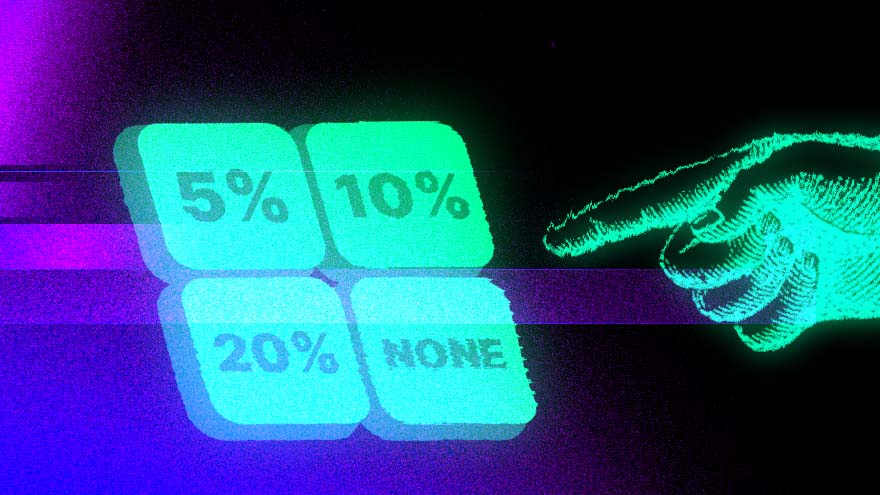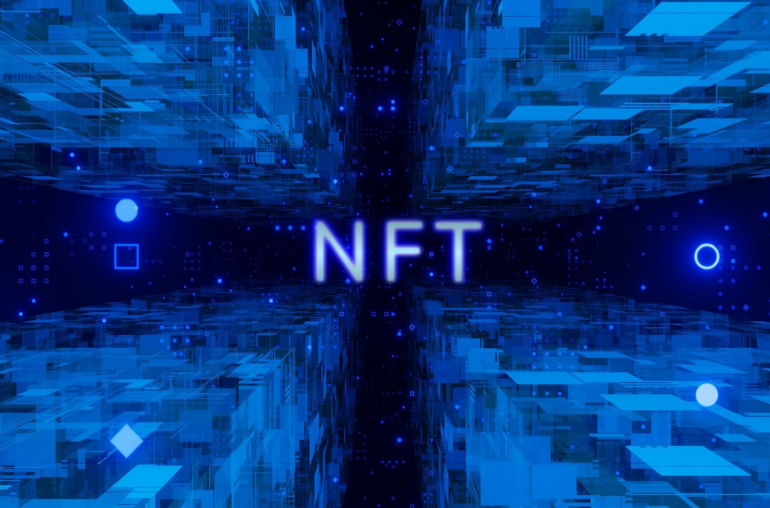Get the 5-minute newsletter keeping 73K+ crypto innovators in the loop.
© Defiant Media Inc 2022
Advertisement
X2Y2’s Move to Make Royalties Optional Triggers Outcry and Soul-searching in NFT Land
By: Aleksandar Gilbert
On a hot and humid Tuesday night, collectors flocked to a sweltering art gallery in Lower Manhattan. It was their one opportunity to snag a physical copy from Justin Aversano’s “Cognition,” a series of 364 mixed-media pieces the grieving artist created in 2014 after the death of his mother.
Sitting in a back room away from the crowd, the DJ, and gallery staff, Aversano explained how he had come to crypto.
“I do think what got me into NFTs in the first place was the fact that royalties were a thing, and this technology pushed it forward for artists to be able to be sustainable off their royalties,” Aversano said. “It’s a paradigm shift.”
Artists have long relied on royalty payments from secondary sales of their work to earn their livelihoods. In industries dominated by studios and publishers and agents and talent managers, that’s been a struggle. Stories are legion of artists forced to seek redress through lawsuits.
The advent of non-fungible tokens promised to provide artists with a handy digital tool for collecting their due with little fuss. Thanks to smart contracts, creators could now expect to receive regular and reliable payments for their handiwork far more seamlessly than in the past. After all, that’s the primary purpose of blockchain technology — to do away with intermediaries and friction and make transactions more efficient.
But now that business model may be in jeopardy, casting doubt on one of the core themes of web3 — creative freedom empowered by crypto.
On Aug. 26, NFT marketplace X2Y2 made royalty payments optional, citing competition from fast-growing, royalty-free competitor Sudoswap. No surprise, the number of buyers on the site paying full royalties the following week fell to 88% from 96%, according to X2Y2.
Artists pushed back, and X2Y2 partially reversed course. But its action jolted creators who realized that royalty payments were less a paradigm shift than glorified tip jar.
“If this becomes the trend, I’m out of web3,” Amber Vittoria, a New York-based artist, tweeted. “Ignoring a creator’s royalties is not innovative, it’s regressive.”
If this becomes the trend, Im out of web3. Ignoring a creators royalties is not innovative, its regressive.
Aversano isn’t the only artist who embraced the promise of NFT-supported royalties. On a panel discussion on Sept. 2 hosted by X2Y2, several artists spoke about how important royalties were in attracting them and their peers to blockchain technology.
“Every culturally significant person that I know that is on the fence about this space has said that the only thing that intrigues them is the fact that they get royalties,” said Pat Dimitri, a musician. “And that it seems like artists are actually fairly compensated for their output for the first time, maybe ever.”
But there’s a hitch: royalty payments are easily bypassed.
NFTs are smart contracts, and within each NFT, artists input what their royalty percentage should be, Wacky Chainer, the pseudonymous director of business development at X2Y2, told The Defiant.
But those contracts do not automate the collection and distribution of royalty payments.
“It’s always been the — I don’t want to call it benevolence, but there was an understanding that marketplaces would collect those royalties for the creators and redistribute them,” he added.
In the race to build volume from collectors in a bear market, marketplaces are now under pressure to drop royalties.
Royalty-free NFT marketplace Sudoswap launched July 9. Two months later, it is the fourth-most popular platform to buy and sell NFTs, according to NFT data platform NFTGO.
OpenSea still sits atop the market, but its share has dropped this year amid the rise of Sudoswap and X2Y2, both of which charge lower trading fees. X2Y2, which went live in February, is doing $9.1M in daily volume compared to about $15M at OpenSea, according to DappRadar.
With Sudoswap nipping at its heels, X2Y2 announced on Aug. 26 it would let buyers decide whether to pay artist royalties. The decision was spurred, in part, by Sudoswap’s joining the roster of marketplaces on NFT aggregator Gem, which lets buyers compare prices across different platforms. Gem was acquired by OpenSea earlier this year.
“You already had other marketplaces that are doing 0% [royalties], it’s just that they weren’t as popular,” Wacky said.
Gem developer Vasa has said the platform will give buyers the option of paying royalties on NFTs purchased from Sudoswap, though he did not provide a timeline for its implementation.
Following outcry from artists, X2Y2 pivoted and announced it would reinstate mandatory royalty payments for smaller NFT collections and let the owners of artwork from larger collections decide among themselves, via majority vote, whether to enforce royalty payments.
Nevertheless, the experience was a wake up call, according to artists who participated in the panel hosted by X2Y2 on Sept. 2.
Dylan Shub, the founder of the Fat Cats NFT collection, said artists had been fooled by marketplaces that had courted them without explaining how NFT royalty payments work. Mr0, a pseudonymous developer at crypto firm QuantumTECH, agreed.
The royalties and all that were really just a marketing mechanism.
“The marketplaces for the most part knew this,” Mr0 told the panel. “But they had a supply issue of needing to onboard a ton of artists into the space, so you have to start selling dreams at that point. The royalties and all that were really just a marketing mechanism.”
Participants agreed there was little that could be done technology-wise to enforce royalty payments. Mr0 said it would simply begin a “game of cat and mouse.” Some said the likeliest path forward was to make it a cultural expectation, like tipping at restaurants.
“When you go to a restaurant, we all think someone’s an asshole if they don’t tip the waiter or waitress, right? We’ve ingrained it as part of our culture,” Shub said. “If we can cultivate a culture where people feel part of the community and want to pay the royalties because it’s a good feeling, you know, that’s very helpful.”
Musician Dimitri said shaming people into doing the “right thing” could work. But it would, in a sense, replicate the system he had hoped NFTs would replace.
“I can tell you very honestly, in 10 years in the music industry in Web2, I’ve had to fight tooth and nail to get paid plenty of times,” he said. “And I would prefer to not keep doing that. Web3 was hopefully … a path to avoid having to fight people for the money that I’ve earned.”
An After Hours Odyssey Through NFT.NYC Reveals Pyramids, McGoblinBurgers, and a Hefty Dose of Optimism
Some artists have discussed blacklisting marketplaces that let buyers bypass royalty payments, Wacky told The Defiant. DeGods, the team behind a popular NFT collection on the Solana blockchain, have said buyers who refuse to pay royalties will not be entitled to perks that come with ownership of a DeGod NFT, such as future airdrops.
“This whole royalty war is going to change the NFT landscape,” Wacky predicted. It may impact artists’ livelihoods. Or it might “bring about a slew of very competitive creators,” working hard to cultivate “very reliable and loyal customers” who are willing to pay royalties, elevating the NFT artscape.
Standing outside the Manhattan gallery Tuesday night, pseudonymous NFT collector ThePregnantChad held one of the 364 pieces in “Cognition,” which had been carefully packaged to protect it from the rain.
He entered the market in February looking to make a quick buck flipping NFTs, and found them beautiful. He now collects them for aesthetic pleasure, and is happy to pay royalties — to “true, fine artists.”
“If you’re jumping into the space and you’re looking to fucking move a lot of pieces, and you’re looking to build a lot of revenue real quick or whatever the case may be, more power to you, but then I’m not looking to support those royalties,” he said.
“But as an artist, you know, someone like Justin Aversano, or somebody like Process Grey … yeah, those people deserve royalties. Like that’s why we get the beauty, the beauty that we’re getting right now. And I love that part about the blockchain. I don’t want to change that.”
Rahul Nambiampurath•
Owen Fernau•
Samuel Haig•
Samuel Haig•
Rahul Nambiampurath•
Advertisement


